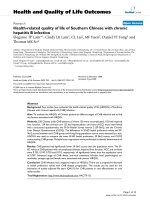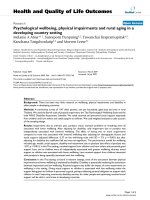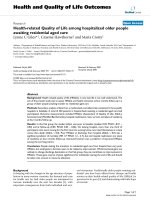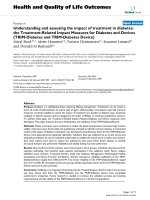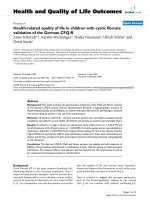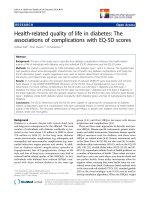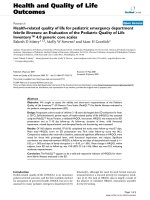báo cáo hóa học:" Thrombin related peptide TP508 promoted fracture repair in a mouse high energy fracture model" docx
Bạn đang xem bản rút gọn của tài liệu. Xem và tải ngay bản đầy đủ của tài liệu tại đây (1.23 MB, 10 trang )
BioMed Central
Page 1 of 10
(page number not for citation purposes)
Journal of Orthopaedic Surgery and
Research
Open Access
Research article
Thrombin related peptide TP508 promoted fracture repair in a
mouse high energy fracture model
Brain M Hanratty
1
, James T Ryaby
2
, Xiao-Hua Pan
3
and Gang Li*
1,4
Address:
1
Department of Orthopaedic Surgery, School of Biomedical Sciences, Queen's University Belfast, 97 Lisburn Road, Belfast, BT9 7B, UK,
2
Research and Development, OrthoLogic Corp, 1275 West Washington Street, Tempe, AZ, USA,
3
Department of Orthopaedic Surgery, People's
Hospital of Shenzhen City, Shenzhen, PR China and
4
Department of Orthopaedics & Traumatology, The Chinese University Hong Kong, Clinical
Sciences Building, Prince of Wales Hospital, Shatin, Hong Kong, PR China
Email: Brain M Hanratty - ; James T Ryaby - ; Xiao-Hua Pan - ;
Gang Li* -
* Corresponding author
Abstract
Background: Thrombin related peptide (TP508) is a 23 amino-acid synthetic peptide that
represents a portion of the receptor-binding domain of thrombin molecule. Previous studies have
shown that TP508 can accelerate musculoskeletal tissue repair including fracture healing.
Objectives: The aim of this study was to investigate the effect of TP508 on fracture healing in a
murine fracture model representing high energy fracture situation.
Methods: Eighty CD 1 mice underwent controlled quadriceps muscle crush and open transverse
mid diaphyseal femoral fracture that was then fixed with an external fixator. Animals were
randomised into four groups to receive an intra-operative dose of either 100 μg TP508 into the
fracture gap; 100 μg TP508 into the surrounding damaged muscle tissues; 10 μg TP508 into the
fracture gap, or control equal amount of saline into the fracture gap. Radiographic assessment was
performed weekly for 5 weeks; histological analysis was at 3 and 5 weeks post fracture and
biomechanical testing of the fractured bone was performed at 5 weeks post fracture.
Results: Mechanical testing data showed that the fracture stiffness was significantly higher in the
group receiving 100 μg TP508 into the fracture gap than other groups. Histological and
radiographic analysis revealed a trend of increase in bone formation in the 100 μg TP508 injected
into the fracture gap group compared to the saline control group. It was noted that the scar tissues
was significantly less in Group II comparing with the saline control group and there was increased
blood vessel formation in the crushed muscles and fracture gap areas in the groups receiving TP508
comparing to the saline control group.
Conclusion: The results from this study demonstrated the use of thrombin related peptide TP508
in the situation of a high energy fracture can promote fracture healing and reduce the potential
complications such as muscle fibrosis and fracture delayed or non-union.
Published: 29 January 2009
Journal of Orthopaedic Surgery and Research 2009, 4:1 doi:10.1186/1749-799X-4-1
Received: 12 August 2008
Accepted: 29 January 2009
This article is available from: />© 2009 Hanratty et al; licensee BioMed Central Ltd.
This is an Open Access article distributed under the terms of the Creative Commons Attribution License ( />),
which permits unrestricted use, distribution, and reproduction in any medium, provided the original work is properly cited.
Journal of Orthopaedic Surgery and Research 2009, 4:1 />Page 2 of 10
(page number not for citation purposes)
Background
Some 5–10% of patients that suffer a fracture throughout
the world have problems with fracture healing. These
include malunion, delayed union, non union, infection
and avascular necrosis. After a fracture occurs the ability of
a fracture to heal depends on several factors that include
the systemic ability of the patient, the location of the frac-
ture and the type of treatment received. Of the variables
that can affect the rate of healing the amount of energy
that causes the fracture has significance, the extent of inju-
ries to the surrounding soft tissue may determine the frac-
ture healing outcome. This is recognised by its inclusion
in several scoring systems to help predict clinical out-
comes and higher energy fractures are at greater risk of
complications such as infection, delayed union or non-
union.
Thrombin related peptide (TP508) represents one of the
receptor binding domains of thrombin and several in vitro
and in vivo studies have shown that TP508 had positive
effects in the repair of the musculoskeletal tissues [1-3].
The positive effects of TP508 involve changes in the
inflammatory response, enhancing cell recruitment and
angiogenesis [4]. Since TP508 has been reported to pro-
mote fracture healing and the high energy fracture is
always associated with soft tissue damages at the fracture
sites, we hypothesized that administration of TP508 into
the fracture site or into the damaged soft tissue site in a
high-energy fracture model would benefit the fracture
repair.
A mouse fracture model of delayed fracture healing simi-
lar to clinical conditions of high-energy fracture was orig-
inally described by Bunn et al [5] and was a development
from a previous validated mouse open femur osteotomy
models [6,7]. The aim of this study was to test the effec-
tiveness of a single injection of TP508 given at time of sur-
gery in the established mouse fracture model with
controlled muscle crush that mimics high energy fracture
healing.
Methods
Animal model of high energy fracture
3 month old CD1 mice were used with age ranging from
12–14 weeks and mean body weight of 39.75 +/- 3.026 g.
General anaesthetisa was induced using 2% isoflurane in
a nitrous oxide: oxygen (50:50) mixture at 400 ml/min in
a sealed chamber. The skin was incised along the length of
the femur from the left knee to the greater trochanter, the
fascia lata was then incised and split distally starting from
the prominent landmark of the adductor tubercle. The
muscle bellies of the overlying quadriceps and hamstring
muscles beneath were gently parted to gain access to the
femoral diaphysis. The quadriceps muscle belly was
crushed using a custom made crush forceps and crushing
jig as previously described [5]. In brief, the crush forceps
were passed either side of the quads muscle, and then the
forceps and mouse were positioned in the muscle-crush-
ing jig as shown in Fig. 1. A weight of 200 g was released
from a 130 mm height to injure the quadriceps muscle
and the crushed muscle was approximated to its original
position on the femoral diaphysis. A femoral osteotomy
was then performed according to the methods reported
previously and fracture was fixed with an external fixtor as
described before [6,7]. The skin was closed and a digital
radiograph was carried out immediately to ensure correct
fracture fixation.
Post operatively the animals were placed in individual
cages and were recovered under heating lamps and mats
in the first 24 hours. They were allowed unlimited cage
activity until the day of termination.
Randomisation and injection of TP508
To ensure no bias in the animal selection, a randomisa-
tion and coding was used to assign each animal to a
group. When an individual animal was prepared for the
operation it was given a numeric code from the list and
allocated into whatever treatment group tagged to that
code. This meant that the main investigator was blinded
to the groups at time of outcome measurement.
There were 4 experimental groups and each contained
twenty animals. At the time of surgery, Group I received
an injection of 100 μg TP508 in 20 μl PBS into the fracture
gap; Group II received an injection of 100 μg TP508 in 20
μl PBS into the surrounding damaged muscle; Group III
received an injection of 10 μg TP508 in 20 μl PBS into the
fracture gap and Group IV as the control group received an
injection of 20 μl PBS saline into the fracture gap.
Mechanical testing
After termination, the skin over both limbs was removed.
The surrounding muscle then removed by sharp dissec-
tion, the quadriceps muscle carefully isolated, excised and
preserved. Both femurs were disarticulated from the pelvis
and knee joints taking care not to disrupt the structural
integrity of the fracture site. The external fixators were
removed by cutting through the pins using a diamond cut-
ting disc and a haemostat to prevent pin spinning. The pin
remnants were removed by gentle anti-clockwise rotation.
Both femoral samples were then placed in a container
with saline soaked gauze at room temperature 22°C and
all mechanical tests performed within 4 hours post exci-
sion.
From each group 8 specimen pairs were tested to failure
by 3-point bending using a 100 N load cell (Lloyd Instru-
ments Ltd, UK). Each specimen was placed on two lower
supports that were 9 mm apart and force applied at 5 mm/
Journal of Orthopaedic Surgery and Research 2009, 4:1 />Page 3 of 10
(page number not for citation purposes)
min at the mid-diaphysysis on the anterior surface such
that the tension was in the posterior surface. Load dis-
placement curves were generated and from these ultimate
load and stiffness were determined for each specimen. The
biomechanical properties of the fractured femur were
expressed as a percentage of the contra lateral unfractured
bone properties. In each instance the same person carried
out the test. Every sample was coded so as to blind the
investigator.
Radiography analysis
Radiographs were taken at day 1, 7, 14, 21, 28 and 35
post-surgery. All the animals were anaesthetised and
placed inside a high resolution digital radiography system
(Faxitron MX-20, Faxitron X-ray Corporation, IL, USA).
The facitron was calibrated before the procedure at a
standard X-ray dose of 24 KV for 3 seconds at a distance of
12 cm. To control the plane of radiography a specifically
made X-ray jig was attached to the external fixators via two
portals in the crossbar. The animal was moved to the
prone position on the jig, and placed centrally using the
cross hairs for guidance. To monitor variations in x-ray
beam penetration, an aluminium step-wedge phantom
was attached to the jig and included in each radiograph
taken. This technique meant that standardised lateral
orthogonal x-rays were performed in an accurate and
repeatable fashion.
Digital radiographs were taken in the TIFF format, coded
and analysed by comparing the changes in pixel density
across the fracture gap using UTHSCSA Image Tool pro-
gram
. Changes in pixel density
corresponded with changes in bone mineralised tissue.
Semi-quantitative analysis of the pixel density across the
fracture gap was used and intra and inter observer variabil-
ity measured using linearly weighted kappa and this
showed a highly reproducible analysis. In brief five pixel
density histograms were generated across the fracture gap
and the pattern generated allocated a score of minus 1, 0
or plus 1 thus giving a maximum score for each radio-
A. Crushing jigFigure 1
A. Crushing jig. B. Crush forceps in situ within crush jig. C. Custom made crush forceps.
Journal of Orthopaedic Surgery and Research 2009, 4:1 />Page 4 of 10
(page number not for citation purposes)
graph of plus 5 and minimum of minus 5. Fracture callus
size was measured and expressed as a ratio of the average
femur diameter.
Histology examination
At 3 and 5 weeks post fracture, six animals from each
group were sacrificed for histology examination. The
femur was disarticulated from the pelvis and knee joints
taking care to avoid disturbing the fracture callus. The
bone specimen was coded and fixed for 48 h in 10% buff-
ered formalin, then placed in 20% formic acid at 4°C for
three weeks to decalcify. The specimen was ready when a
green needle could pass easily through the bone. Decalci-
fied samples were processed through graded alcohols,
xylene and embedded in paraffin wax. The orientation
was in the longitudinal plane such that all the fixator's
holes were visible. 6 μm sections were cut, dewaxed in
xylene and rehydrated through alcohol, then stained with
haematoxtylin and eosin, and mounted using DPX. The
quadriceps muscle specimens from each animal were also
collected and embedded for histology analysis of scar tis-
sue formation and blood vessels. Muscle from group II
(100 μg injected into the soft tissues) was compared to
that of group IV (Control). The area of scar tissue visual-
ised on cross-sections of muscle was measured using
image analysis software (Bioquant, Nova Version 4.00.8
Advanced Image Analysis, R&M Biometrics, Inc, USA) and
expressed as a percentage of the total area of muscle cross-
section (Fig 2). Blood vessels were immunostained by spe-
cific endothelial antigen marker CD31 on the paraffin sec-
tions as previously described [5] and the total number of
blood vessels present in the fracture gap and crushed mus-
cles was counted.
For digital photography, the slides were coded and a dig-
ital image of the fracture was taken using an Leica Micro-
systems camera and soft ware (Leica IM 50, Leica
Microscopy Systems Ltd, Heerbrugg, Switzerland). The
magnification was × 2.5 to ensure the whole of the frac-
ture callus was included, and all pictures were taken the
same sitting to ensure reproducibility. These images were
transferred to Adobe Photoshop 7.0 (Adobe, San Jose,
California, USA), and similar sized image showing only
the fracture gap was cropped. Image analysis was carried
out using image analysis software (Bioquant, Nova Ver-
sion 4.00.8 Advanced Image Analysis, R&M Biometrics,
Inc, USA). The amount of callus, fibrous tissue and carti-
lage in the fracture gap were quantified and compared.
Statistical analysis
All quantitative data were transferred to the statistical pro-
gram SPSS (Version 14, Chicago IL, USA). Analysis was
carried out using non-parametrical tests, displaying distri-
butions by means of boxplots and comparing groups with
the Mann Whitney U test. Differences between groups
were considered significant at p < 0.05.
Results
Aetiology
There were no statistically significant differences between
the four groups of animals when comparing the age,
weight and change in animal weight. During the experi-
ment six animals died. Two animals, one from group I
and another from group II did not survive anaesthesia
when weekly radiographs were being taken, and another
from group I had mechanical failure at week two and was
killed humanly by terminal anaesthesia. Three animals
from group IV did not regain nerve function in the oper-
ated limb following surgery and were killed humanly.
These animals were replaced by littermates, so that each
group contained twenty animals. Of the animals that sur-
vived the experiment, at the time of dissection 9 had non-
union and two had evidence of mechanical failure of the
external fixator. The animals that had non-union were
made up of 4 from the control group, 2 from group II and
3 from group III. In the 2 animals of the non-unions from
group III, there was evidence of deep infection.
Radiographic assessments
There was no difference between the groups on day of sur-
gery. Group I had shown the gradual improvement of
bone formation in radiographic appearance through the
time points (day 0 to day 35). The fracture showed sign of
union in Group I at day 35 post-fracture. There was no dif-
ference between Group II or III compared to Group IV at
all the time points (Fig 3A). The semi-quantitative analy-
sis showed a delay in healing through out the five weeks
in all groups. There was no difference between the groups
in the first three weeks but at five weeks Group I differed
in having more bone formation across the fracture gap,
which was the only group to achieve a positive score (Fig
3B).
Mechanical testing
Results of the mechanical testing are shown in (Fig 4). The
percentage ultimate loads showed no statistically signifi-
cant difference between the groups but there was a trend
of increasing strength towards Group I; the control group
had less strength and stiffness compared to the other
groups (Fig 4A). There were statistically significant differ-
ences in the percentage stiffness between Group I (100 μg
TP508 injected into fracture site) and Group IV the con-
trol (p < 0.05); and there was no statistically significant
differences between the other groups (Fig 4B).
Histological analysis
On day 21 post-fracture, the amount of periosteal and
endosteal callus (woven bone) in the fracture gap was
greatest in Group I; periosteal callus was most evident in
Journal of Orthopaedic Surgery and Research 2009, 4:1 />Page 5 of 10
(page number not for citation purposes)
group I followed by Group III; Groups II and IV had
mostly fibrous tissue and cartilage in the fracture gap at
this time (Fig 5A). At day 35 post-fracture, Group I and II
had the most bone across the fracture gap followed by
group III; Group IV had the least amount of bone; perio-
steal callus was most evident in group II, and least in
group IV (Fig 5B). The scar tissues were significantly
reduced in Group II comparing with the control group
(Fig 2A–C) and there was a trend of increased blood vessel
formation in the crushed muscles and fracture gap areas in
the groups receiving TP508 comparing to the saline con-
trol group (not shown).
Discussion
In this study the synthetic peptide TP508 was tested in a
mouse model mimicking high energy-fracture conditions
with soft tissue injuries, and showed positive effects on
enhancing fracture healing. The time to union in mouse
A-C. Histological measurement of scar tissue present in cross sections of muscle taken from animals after three weeksFigure 2
A-C. Histological measurement of scar tissue present in cross sections of muscle taken from animals after
three weeks. Group II (A) had a mean of 13% and range 4–18% scar tissues, whereas group IV (B) had a mean of 22% and
range of 14–23%. C. There was statistical difference between the groups (p = 0.016).
Journal of Orthopaedic Surgery and Research 2009, 4:1 />Page 6 of 10
(page number not for citation purposes)
fracture models is about 3 weeks [6,7], but in the current
study, most of the animals in the control group did not
achieve fracture union at 5 weeks, suggesting a delayed
fracture union. However, the mechanical, radiographic
and histological data demonstrated a superior fracture
healing in the group receiving an injection of 100 μg
TP508 into the fracture gap. This is in agreement with pre-
vious studies showing the benefit of TP508 in enhancing
healing of various musculoskeletal tissues [8,9]. The
group receiving 10 μg TP508 into the fracture gap did not
lead to a significant improvement of the fracture healing,
suggesting that the dose of TP508 administration is
important. The positive effects of TP508 on tissue repair
appear to be dose-dependent. Previous studies had used
various doses of TP508, ranging from 0.1 μg in excision
wounds in rats [10] to 300 μg in rabbit distraction osteo-
genesis studies [11]. In a rat closed femoral fracture study,
Wang et al [8] noted a TP508 dose dependant increase in
fracture strength, 1 μg TP508 group increased the fracture
strength by 21% and 10 μg TP508 group by 36% relative
to the control group. Since most of the studies have used
TP508 in a soluble injection form and given at the same
time as the injury, and only a small amount of TP508
could retain their bioactivities to the repair phases, there-
fore a higher dose of TP508 is needed to show the positive
effects. Recently, studies have shown that TP508 given in
a slow release microsphere form is more effective in
enhancing bone repair and consolidation even at a
reduced dose [12]. In the present study, we have used two
doses of TP508 (100 and 10 μg/ml) in PBS delivery form
based on the data from previous studies, and the data
showed that the higher dose 100 μg/ml resulted in signif-
icant promoting effects of fracture healing. The use of con-
trolled slow release form of TP508 with the same dose in
the similar animal model will be the subject for future
investigation.
We have also used one group where TP508 (100 μg/ml)
was administrated into the crushed muscle and it was
hoped that TP508 will help to reduce the adverse effects of
the pro-inflammatory cytokines released from the trau-
matised muscles and enhance fracture healing. In vitro and
in vivo studies have shown that TP508 altered the inflam-
matory response through an increase in the expression of
A. Representative radiographs taken at day 0, 21 and 35 for the 4 experimental groupsFigure 3
A. Representative radiographs taken at day 0, 21 and 35 for the 4 experimental groups. Group1 had shown a grad-
ual improvement in callus formation in radiographic appearance through the time points. The fracture showed sign of union in
Group I at day 35 post-fracture. There was no difference between Group II or III compared to Group IV at all the time points.
B. Radiographic analysis data at week 5 post-fracture. Group I (100 μg TP508 injected in the fracture gap) had the largest
amount of callus across the fracture gap compared to the other groups. Statistical analysis was carried out using non-paramet-
rical Mann Whitney U test, difference between groups was considered significant at *p < 0.05.
Journal of Orthopaedic Surgery and Research 2009, 4:1 />Page 7 of 10
(page number not for citation purposes)
A. Mechanical testing data of maximal loadFigure 4
A. Mechanical testing data of maximal load. Properties were expressed as a percentage of maximal load to failure of the
intact femur. This graph shows the strength ratio with Group 1 achieving up to 40% the strength of the contra-lateral intact
bone, which is the highest among the groups.B. Mechanical testing data of stiffness. Properties were expressed as a percentage
of the intact femur. This graph shows the stiffness ratio with Group 1 achieving up to 60% the stiffness of the contra-lateral
bone, which was the highest among the groups and was significantly higher than that of the control group. Statistical analysis
was carried out using non-parametrical tests, displaying distributions by means of boxplots and comparing groups with the
Mann Whitney U test. Difference between groups was considered significant at *p < 0.05.
Journal of Orthopaedic Surgery and Research 2009, 4:1 />Page 8 of 10
(page number not for citation purposes)
A. At 3 weeks post-fracture, periosteal and endosteal callus in the fracture gap was greatest in Groups I and IIIFigure 5
A. At 3 weeks post-fracture, periosteal and endosteal callus in the fracture gap was greatest in Groups I and III.
Groups II and IV had mostly fibrous tissue and cartilage in the fracture gap at this time. B. At 5 weeks post-fracture, Group I
and II had the most bone across the fracture gap followed by group III. Group IV had the least amount of bone in the fracture
gap formed at this point.
Journal of Orthopaedic Surgery and Research 2009, 4:1 />Page 9 of 10
(page number not for citation purposes)
IL-1 and IL-2 [4], and to recruit endothelial cells and oste-
oblasts through chemotaxis to the wounded areas [13-
15]. Wang et al showed in a rat closed femoral fracture
model, a single percutaneous injection of TP508
improved the resultant biomechanical properties of the
healing fracture, and TP508 induced gene expression of
early growth factors, inflammatory response modifiers
and angiogenesis-related factors [8]. The immune genes
and growth factors that have been down-regulated by
TP508 included several MHC Class II genes, Interferon-γ,
IL 1β receptor type 2, IL10 and IL12 [8]. The ability of
TP508 to alter the immune response was also found in the
dermal tissues, in several wound healing studies it was
found that TP508 could suppress inflammatory responses
at later stages of healing [1,10]. These findings are in
agreement with those of Ryaby et al and Li et al who in a
rat closed diaphyseal fracture mode [16] and in a rabbit
distraction osteogenesis model [11,12] described a signif-
icant reduction in the number of inflammatory cells at the
later stages of healing. Although there was no statistical
difference between Group II and the control group in frac-
ture callus volume and mechanical properties, there was
significant reduction of scar tissue formation in the
crushed muscles in group II, suggesting that TP508 may
have a positive effect on muscle repair and regeneration,
and this may in turn to facilitate soft tissue recovery and
angiogenesis following high energy fracture. The use of
TP508 to aid soft tissue healing needs future careful inves-
tigation.
As angiogenesis is an essential part of fracture repair [17]
and early studies have noted that TP508 may have positive
effect on angiogenesis. TP508 was shown to promote both
the size and number of blood vessels in the chick chorio-
allantoic model [13] and TP508 enhances angiogenesis
throug up-regulation of the c-Fos and c-Jun genes and not
the VEGF or MMP-2 genes [14]. This agreed with Varta-
nian et al who used a model of angiogenic sprouting and
showed that TP508 did not increase VEGF gene expression
[18]. In their assay, TP508 stimulated angiogenic sprout-
ing to an extent similar, to the intact thrombin molecule,
but the proteolytically active receptor agonists had no
effect on angiogenic sprouting, thus TP508 may promote
angiogenesis through its non-proteolytic receptor path-
ways [18]. In the present study, we have found that there
was increased blood vessel formation in the crushed mus-
cles and fracture gap areas and significantly reduced scar
formation in the groups receiving TP508 (regardless the
dose) comparing to the saline control group, indicating
that the enhancement of fracture repair by TP508 is par-
tially associated with the enhanced angiogenesis induced
by TP508.
In conclusion, local administration of TP508 (100 μg)
into the fracture gap has promoted fracture repair in a
mouse model of high-energy fracture. The effect appears
to be dose dependent and is associated with reduced
inflammation and enhanced angiogenesis in the sur-
rounding soft tissues and in the fracture gap. TP508 may
therefore be used to argument high energy fracture heal-
ing and more research work is needed to determine the
best form and dose of TP508 delivery for its potential clin-
ical applications.
Competing interests
The authors declare that they have no competing interests.
Authors' contributions
BMH carried out the animal experiments and participated
in experimental design and the first draft of the manu-
script. JTR helped with study design and discussion. XHP
helped with animal experiments and study design. GL was
involved in the study design and overall coordination,
and was the grant holder. All authors read and approved
the final manuscript.
Acknowledgements
We acknowledge the financial support from Orthologic Corporation, USA
for this study.
References
1. Stiernberg J, Norfleet AM, Redin WR, et al.: Acceleration of full-
thickness wound healing in normal rats by the synthetic
thrombin peptide, TP508. Wound repair and regeneration 2000,
8:204-215.
2. Sheller MR, Crowther RS, Kinney JH, Yang J, Di Jorio S, Breunig T,
Carney DH, Ryaby JT: Repair of rabbit segmental defects with
the thrombin peptide, TP508. J Orthop Res 2004, 22:1094-1099.
3. Schwartz Z, Carney DH, Crowther RS, Ryaby JT, Boyan BD:
Thrombin peptide (TP508) treatment of rat growth plate
cartilage cells promotes proliferation and retention of the
chondrocytic phenotype while blocking terminal endochon-
dral differentiation. J Cell Physio 2005, 202:336-343.
4. Naldini A, Carraro F, Baldari CT, Paccani SR, Bernini C, Keherly MJ,
Carney DH: The thrombin peptide, TP508, enhances cytokine
release and activates signaling events. Peptides 2004,
25:1917-1926.
5. Bunn JR, Canning J, Burke G, Mushipe M, Marsh DR, Li G: Produc-
tion of consistent crush lesions in murine quadriceps muscle
– a biomechanical, histomorphological and immuno-histo-
chemical study. J Orthop Res 2004, 22:1336-1344.
6. Connolly CK, Li G, Bunn JR, Mushipe M, Dickson G, Marsh D: A reli-
able externally fixated murine femoral fracture model that
accounts for variation in movement between animals. J
Orthop Res 2003, 21:843-849.
7. Murnaghan M, McIlmurray L, Mushipe MT, Li G: Time for treating
bone fracture using rhBMP-2: A randomised placebo con-
trolled mouse fracture trial. J Orthop Res 2005, 23:625-631.
8. Wang H, Li X, Tomin E, Doty SB, Lane JM, Carney DH, Ryaby JT:
Thrombin peptide (TP508) promotes fracture repair by up-
regulating inflammatory mediators, early growth factors,
and increasing angiogenesis. J Orthop Res 2005, 23:671-679.
9. Sheller MR, Crowther RS, Kinney JH, Yang J, Di Jorio S, Breunig T,
Carney DH, Ryaby JT: Repair of rabbit segmental defects with
the thrombin peptide, TP508. J Orthop Res 2004, 22:1094-1099.
10. Norfleet AM, Huang Y, Sower LE, Redin WR, Fritz RR, Carney DH:
Thrombin peptide TP508 accelerates closure of dermal exci-
sions in animal tissue with surgically induced ischemia.
Wound Repair and Regeneration 2000, 8:517-529.
11. Li G, Ryaby JT, Carney DH, Wang H: Bone formation is enhanced
by thrombin-related peptide TP508 during distraction oste-
ogenesis. J Orthop Res 2005, 23:196-202.
Publish with BioMed Central and every
scientist can read your work free of charge
"BioMed Central will be the most significant development for
disseminating the results of biomedical research in our lifetime."
Sir Paul Nurse, Cancer Research UK
Your research papers will be:
available free of charge to the entire biomedical community
peer reviewed and published immediately upon acceptance
cited in PubMed and archived on PubMed Central
yours — you keep the copyright
Submit your manuscript here:
/>BioMedcentral
Journal of Orthopaedic Surgery and Research 2009, 4:1 />Page 10 of 10
(page number not for citation purposes)
12. Wang Y, Wan C, Szõke G, Ryaby JT, Ryaby JT, Li G: Local injection
of thrombin-related peptide (TP508) in PPF/PLGA micro-
particles enhanced bone formation during distraction osteo-
genesis. J Orthop Res 2008, 26:539-46.
13. Huang Y, Yang Z, Carney D: Effects of thrombin peptides on
wound healing and proliferation and migration of normal
human epidermal keratinocyte (NHEK). Zhonghua Shao Shang
Za Zhi 2000, 16:26-29.
14. Norfleet AM, Bergmann JS, Carney DH: Thrombin peptide,
TP508, stimulates angiogenic responses in animal models of
dermal wound healing, in chick chorioallantoic membranes,
and in cultured human aortic and microvascular endothelial
cells. Gen Pharmacol 2000, 35:249-254.
15. Li G, Cui Y, McIlmurray L, Allen WE, Wang H: rhBMP-2,
rhVEGF(165), rhPTN and thrombin-related peptide, TP508
induce chemotaxis of human osteoblasts and microvascular
endothelial cells. J Orthop Res 2005, 23:680-685.
16. Ryaby JT, Carney DH, Campbell M: Acceleration of fresh fracture
healing with an injectable thrombin peptide in a rat model.
Transactions ORS 2000, 25:877.
17. Hausman MR, Schaffler MB, Majeska RJ: Prevention of fracture
healing in rats by an inhibitor of angiogenesis. Bone 2001,
29:560-564.
18. Vartanian KB, Chen HY, Kennedy J, Beck SK, Ryaby JT, Wang H, Hoy-
ing JB: The non-proteolytically active thrombin peptide
TP508 stimulates angiogenic sprouting. J Cell Physiol 2006,
206:175-180.

